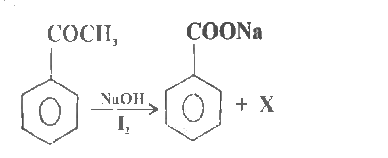Complete Solutions to QUESTIONS of chapter ALDEHYDES, KETONES AND CARBOXYLIC ACIDS of Class 12 book with complete answers and questions
| Class 12 | CHEMISTRY |
| Chapter | ALDEHYDES, KETONES AND CARBOXYLIC ACIDS |
| SUBHASH PUBLICATION | QUESTIONS |
| Number Of Questions | 70 |
| Academic Year | 2023-24 |
Mention the hybridised state of carbonyl carbon.
00:58View SolutionGive the IUPAC name of `CH_(3)CHO`
01:16View SolutionGive the IUPAC name of `CH_(2)=CH-CHO`.
01:20View SolutionWrite the IUPAC name of `CH_(3)COCH_(2) CH_(2)CH_(3)`.
01:43View SolutionExplain Rosenmund reduction of benzoyl chloride.
02:24View Solution
Name the reaction.02:39View SolutionHow would you prepare acetaldehyde from acetyl chloride? Name the reaction.
01:34View SolutionExplain Etards reaction.
01:51View SolutionWhich oxidising agent is used in Etard reaction?
01:34View Solution
Write the name of the above reaction.03:16View SolutionHow benzene is converted into benzaldehyde by Gattermann-Koch reaction?
01:52View SolutionComplete the reaction
 04:18View Solution
04:18View SolutionHow ketone is obtained from Friedel craft's acylation reaction ?
01:34View Solution
Write the structure of X in the above reaction.02:47View SolutionWrite the organic compound formed in the following reaction.
 02:51View Solution
02:51View SolutionExplain the mechanism of additon of HCN to a carbonyl group presence of a base.
02:19View SolutionExplain the addition of ammonia and its derivatives with aldehydes and ketones.
05:23View SolutionWhat happens when the carbonly compounds are treated with hydrazine? Write the reaction.
02:19View SolutionComplete the reaction
 01:39View Solution
01:39View SolutionWrite the organic compound formed in the following reaction
 01:19View Solution
01:19View SolutionHow does propanone `(CH_(3)COCH_(3))` reacts with hydrazine? Give equation.
01:22View SolutionMost of ketones does not give addition compound with sodium bisulphite. Give reason.
01:10View SolutionGive reason : Acetophenone does not react with saturated sodium bisulphite solution.
04:47View SolutionAldehydes are generally more reactive than ketones towards nucleophillic addition reactions. Give two reasons.
02:11View SolutionName the reagent used in the conversion of ketone to hydrocarbon. Name the reaction.
01:38View SolutionComplete and name the following reactions.
(a) View Solution
View SolutionExplain Wolff-Kishner reduction.
01:27View SolutionWhat are P and Q?
View SolutionWhat is Tollen's reagent? How it reacts with aldehydes?
02:46View SolutionWhat is Fehligns solution? How it reacts with aldehydes?
05:29View SolutionExplain haloform reaction.
03:36View SolutionExplain iodoform reaction.
02:36View SolutionGive the IUPAC name of X.
 05:03View Solution
05:03View SolutionGive reason: `prop`- hydrogen atoms of aldehydes and ketones are acidic.
03:52View SolutionExplain aldol condensation with an example.
02:31View SolutionWhat is the action of dil. NaOH on ethanal (acetaldehyde)? Name the reaction.
01:58View SolutionWrite the name of the reaction.
 03:16View Solution
03:16View SolutionWhat is cross aldol condensation. Give an example.
04:14View SolutionHow does benzaldehyde reacts with acetophenone in presence of dilute alkali.
02:43View SolutionEthanal`(CH_3CHO)` undergoes aldol condensation reaction.Give reason.
01:34View SolutionExaplain Cannozzaro reaction with an example.
02:40View SolutionIdentify A and B in the following reaction.
 04:13View Solution
04:13View SolutionAcetaldehyde does not undergo Cannizzaro reaction. Why ?
01:52View SolutionFormaldehyde undergoes Cannizzaro's reaction. Give reason.
01:36View SolutionGiven two uses of formaldehyde.
01:54View SolutionHow are carboxylic acids prepared form Grignard regents ?
01:54View SolutionWhat are Y and Z in the following reactions ?
View SolutionComplete the following reaction.
View SolutionComplete the following reaction.
 02:25View Solution
02:25View SolutionHow are carboxylic acids prepared from nitriles ?
01:38View SolutionCarboxylic acids are more acidic than phenols. Give reason.
02:27View SolutionExplain the effect of electron withdrawing groups. [EWG] on the acidity of carboxylic acids. Give examples.
02:39View SolutionWhat is the effect of electron withdrawing group on the acidity of carboxylic acid ?
02:09View SolutionExplain the effect of electron donating group (EDG) on the acidity of carboxylic acids. Give example.
03:14View SolutionAmong formic acid and acetic acid, which is more acidic ? Give reason.
02:35View SolutionHow `PCl_(3), PCl_(5) and SOCl_(2)` reacts with carboxylic acids ?
02:54View SolutionWrite the chemical equation to convert ethanoic acid to ethanoic anhydride.
01:27View SolutionThe equation for
The reaction between carboxylic acdis and `PCl_(5)`01:19View SolutionGive the equation for
The reaction between formaldehyde and con. KOH.02:21View SolutionGive the equation for
The formation of oxime from carbonyl compound.01:32View SolutionA carboxylic acid is heate with alcohol in presence of con. `H_(2)SO_(4)`. Name of the reaction Give its general equation.
01:55View SolutionComplete the equation.
View SolutionHow carboxylic acids react with ammonia ?
01:26View SolutionHow do you convert benzoic acid to benzamide ? Write the equation.
02:03View SolutionWhat is the major product of the following reaction.
 01:52View Solution
01:52View SolutionExplain decarboxylation reaction with an example.
02:30View SolutionWhat is soda lime ?
01:32View SolutionExplain HVZ reaction with example.
02:29View SolutionComplete the reaction
View SolutionComplete the equation
`CH_(3)COONa overset(NaOH+CaO)underset(Delta)to`02:45View Solution
QUESTIONS questions and complete solutions for chapter ALDEHYDES, KETONES AND CARBOXYLIC ACIDS of JEEVITH PUBLICATIONS CHEMISTRY (KANNADA ENGLISH) of Class 12
